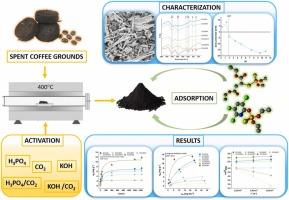当前位置:
X-MOL 学术
›
J. Hazard. Mater.
›
论文详情
Our official English website, www.x-mol.net, welcomes your
feedback! (Note: you will need to create a separate account there.)
The adsorption of chlorpyrifos and malathion under environmentally relevant conditions using biowaste carbon materials
Journal of Hazardous Materials ( IF 12.2 ) Pub Date : 2024-09-23 , DOI: 10.1016/j.jhazmat.2024.135940 Vedran Milanković, Tamara Tasić, Snežana Brković, Nebojša Potkonjak, Christoph Unterweger, Igor Pašti, Tamara Lazarević-Pašti
Journal of Hazardous Materials ( IF 12.2 ) Pub Date : 2024-09-23 , DOI: 10.1016/j.jhazmat.2024.135940 Vedran Milanković, Tamara Tasić, Snežana Brković, Nebojša Potkonjak, Christoph Unterweger, Igor Pašti, Tamara Lazarević-Pašti

|
Water bodies face persistent contamination from organophosphorus pesticides like chlorpyrifos and malathion, which pose substantial environmental and health hazards due to their toxicity and resilience in ecosystems. This study explores the potential of spent coffee grounds, a common agricultural byproduct, as an eco-friendly adsorbent for eliminating these pesticides from polluted water. Spent coffee grounds underwent carbonization at 400 °C and various activation treatments using KOH, H3PO4, CO2, and their combinations. The impact of these activation methods on the adsorption capacity of carbonized materials was assessed under environmentally relevant conditions (25 °C, pH=6, and typical pesticide concentrations in wastewater). Results revealed that the physical and chemical properties of biowaste-derived materials significantly influence their adsorption efficiency, with KOH-activated adsorbents exhibiting the highest capacities ((16.1 ± 0.8) mg g−1 for chlorpyrifos and (11.2 ± 0.2) mg g−1 for malathion). Spent coffee grounds carbonized at 400 °C without additional activation demonstrated similar adsorption performance to the best-performing material ((19.4 ± 0.4) mg g−1 for chlorpyrifos and (10.6 ± 0.4) mg g−1 for malathion), with notably lower economic and environmental costs. Given its straightforward preparation and significant adsorption capacity, this material stands out as a sustainable solution for treating agrochemical wastewater containing chlorpyrifos and malathion.
中文翻译:

使用生物废料碳材料在环境相关条件下吸附毒死蜱和马拉硫磷
水体面临毒死蜱和马拉硫磷等有机磷农药的持续污染,这些农药因其毒性和生态系统的恢复能力而对环境和健康造成重大危害。这项研究探讨了废咖啡渣(一种常见的农业副产品)作为一种环保吸附剂的潜力,用于消除污水中的这些农药。用过的咖啡渣在 400 °C 下进行碳化,并使用 KOH、H 3 PO 4 、CO 2及其组合进行各种活化处理。在环境相关条件(25°C,pH=6,废水中典型农药浓度)下评估了这些活化方法对碳化材料吸附能力的影响。结果表明,生物废物衍生材料的物理和化学性质显着影响其吸附效率,KOH活化的吸附剂表现出最高的容量(毒死蜱为(16.1±0.8)mg g -1 ,毒死蜱为(11.2±0.2)mg g -1对于马拉硫磷)。在 400 °C 下碳化且无需额外活化的用过的咖啡渣表现出与最佳性能材料相似的吸附性能(毒死蜱为 (19.4 ± 0.4) mg g −1 ,马拉硫磷为 (10.6 ± 0.4) mg g −1 ),并且吸附率显着降低经济和环境成本。鉴于其简单的制备方法和显着的吸附能力,该材料成为处理含有毒死蜱和马拉硫磷的农用化学品废水的可持续解决方案。
更新日期:2024-09-25
中文翻译:

使用生物废料碳材料在环境相关条件下吸附毒死蜱和马拉硫磷
水体面临毒死蜱和马拉硫磷等有机磷农药的持续污染,这些农药因其毒性和生态系统的恢复能力而对环境和健康造成重大危害。这项研究探讨了废咖啡渣(一种常见的农业副产品)作为一种环保吸附剂的潜力,用于消除污水中的这些农药。用过的咖啡渣在 400 °C 下进行碳化,并使用 KOH、H 3 PO 4 、CO 2及其组合进行各种活化处理。在环境相关条件(25°C,pH=6,废水中典型农药浓度)下评估了这些活化方法对碳化材料吸附能力的影响。结果表明,生物废物衍生材料的物理和化学性质显着影响其吸附效率,KOH活化的吸附剂表现出最高的容量(毒死蜱为(16.1±0.8)mg g -1 ,毒死蜱为(11.2±0.2)mg g -1对于马拉硫磷)。在 400 °C 下碳化且无需额外活化的用过的咖啡渣表现出与最佳性能材料相似的吸附性能(毒死蜱为 (19.4 ± 0.4) mg g −1 ,马拉硫磷为 (10.6 ± 0.4) mg g −1 ),并且吸附率显着降低经济和环境成本。鉴于其简单的制备方法和显着的吸附能力,该材料成为处理含有毒死蜱和马拉硫磷的农用化学品废水的可持续解决方案。











































 京公网安备 11010802027423号
京公网安备 11010802027423号